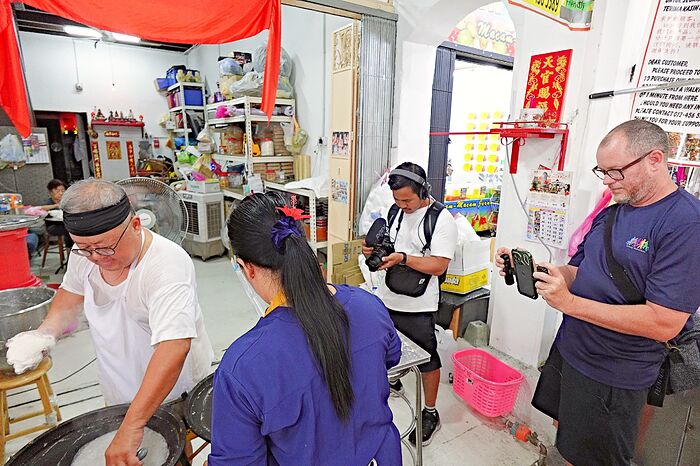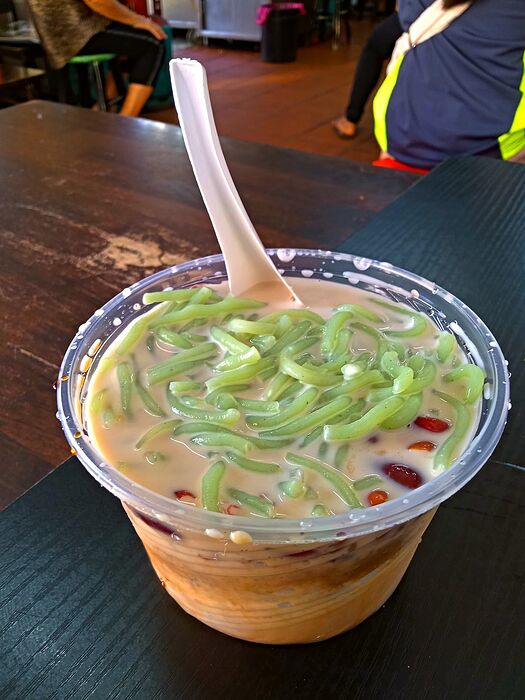Peter (@klyeoh) walked my wife and I through the Chowrasta Market the day after CNY. A beautiful sunny day to be out exploring, all the more special with one of the most knowledgeable food and culture historians of the local scene.
The harmonious blend of so many diverse cultures and food is nothing short of amazing. It was a privilege to try treats from many differenet countries, with local flair added.
Apom King was banging out fresh Apom. I was such a newb that I crushed the first one I tried to pick up, crushing the delicate sides. They showed me the proper method, pinch and pick up from the middle, voila!!
Light and crispy, these strongly brought back memories of the egg rolls my mom bought freshly made from street venders in Hong Kong.
In Singapore, most hawker stalls are enscounced in government hawker centers. Hawker stalls here are in individual buildings, or grouped under common ownership with a major owner.
We strolled, gawked and GRAZED from street to street, stall to stall. Peter giving us insights from his multi-decades ancestral foundation on the Malay Peninsula.
My wife is sweets-adversed, but really developed a taste for Chendul. Jelly noodles made from rice flour with pandan, shaved ice, palm sugar and coconut milk.
Within the same building, 4 or 5 stalls were dishing out all kinds of goodies. Grab a table and stools where you can and grub!
Char Kway Teow, with LARGE shrimp. Wok Hei up the Ying!!!
Hit up some more places, it was 10am and seating was getting scarce. We just walked through a few more famous joints, with Peter telling us the very interesting back stories of each.
We scored seats in Penang Road Famous Laksa. Joint was hopping!!! A few years ago, business was not so good. The son who inherited the restaurant was in financial difficulties. Miraculously, they were given Michellin recognition. The rest, as they say, is history!!!
We moved onto Tua Pui Curry Mee, a single stall with its own building.
Peter told us about their Nutmeg drink, a beverage not so common in the West. Seems that Nutmeg as a spice was a precious commodity, the flesh, not so much.
The ever industrious and frugal Asians concocted a beverage from juicing the nutmeg flesh. Quite refreshing and makes a good story.
We had the Curry Mee, of course. Curry, Pork Blood, Fried Pork Skin, Mint, Basil and more. Oh, and TWO types of noodles for texture, that’s how they roll.
Speaking of rolling…I was starting to roll from place to place. We walked around some more, and ooh and ahh’d at the temples and the secret tunnels and mysteries that abound from history.
I am fascinated by the Shophouses. Shops facing the street, with the owners living behind and above. Many of these shophouses are now full-on shops, with 4 or 5 rooms extending linearly waaaay back off the street. Most with open courtyards and skylights that let in the sunlight, many delightful nooks and crannies around every corner.
By then, it was high noon and in the 90°f and time to retreat to our hotel. We passed a gentleman selling Samosas and more, difficult to pass up. Woulda made a nice snack back in our room with a chilled Tiger Beer. Next time!!!
Thanks again for a most informative and delicious walk, Peter!! Hope you will excuse my inaccuracies, so much to see and experience!! Best walking tour, ever!



























































